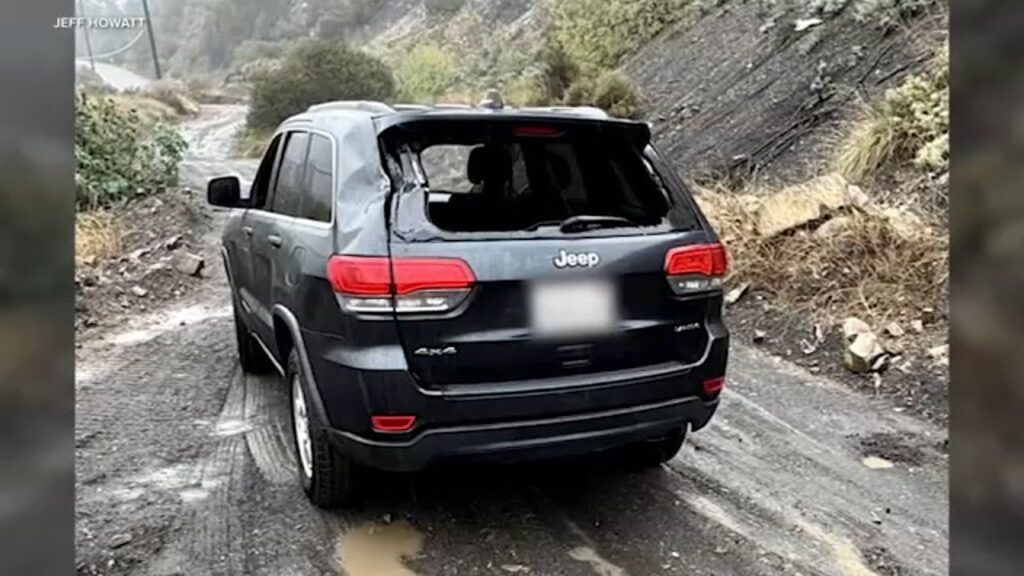Last week in the foothills near Ojai in Ventura County (Southern California), a dramatic and chilling scene unfolded during heavy rain: a large boulder broke free from a hillside slope and slammed into a driver’s SUV, a Jeep, in a matter of seconds. The dash‑ or surveillance‑style footage captures the moment when a torrential downpour loosens rock and debris above the roadway, sending the massive rock tumbling into the path of the vehicle. youtube.com+1
The viewer sees the rain‑soaked hillside, slick with water, the kind of terrain that becomes unpredictable when saturated. Then a rock dislodges—likely due to the combined effects of erosion, rainfall infiltration, and gravity—and it rolls down, gaining momentum. The Jeep is driving along the mountain road, and before the driver has time to react, the boulder crashes into it. The impact is brutal; the SUV is damaged, the driver’s reaction frozen in that split second of shock. The footage serves as a stark reminder of how quickly a seemingly stable landscape can turn hazardous during adverse weather.
From a safety and geotechnical perspective, the incident highlights several critical factors. First: rainfall in mountainous terrain increases the risk of rock‑fall and landslides. When rain soaks into cracks and pore spaces in rock and soil, the effective weight of the slope increases and the frictional resistance that keeps rocks in place decreases. Once a triggering event—such as intense rainfall, seismic vibration, or undercutting—is present, a rock or boulder may detach and follow the path of least resistance down the slope. In this case, the hillside above the road was likely undercut or saturated enough that the boulder broke free.

Second: mountain roads often hug slopes or cuts through hillsides, putting vehicles in the “run‑out” zone of potential rock‑fall. Here, the driver in the Jeep was driving along a roadway beneath a slope affected by heavy rain, so the risk was elevated. Even though heavy rain might prompt reduced speed or extra caution, drivers may not always anticipate a massive rock falling directly toward their vehicle.
Third: the timing and speed matter. In the footage, there’s little forewarning. The rain, windy conditions, and potential poor visibility might already reduce a driver’s ability to detect hazard signs—such as debris on the road, small rocks, or cracks on the slope above. The boulder hits before any meaningful evasive action can be taken, underscoring just how fast these events unfold.
From the driver’s point of view, the experience must have been terrifying. One moment driving through difficult weather conditions, the next a massive chunk of rock comes out of nowhere. Even if seat‑belts and airbags functioned correctly, the physical and psychological shock is significant. Fortunately, there’s no public report (at least in the available coverage) of fatalities in this particular incident, though the vehicle was heavily damaged. The video is described by news outlets as “seriously damaging an SUV” in the hillside area near Ojai during the rain. youtube.com+1
For drivers in similar conditions—especially in mountainous or hillside terrain during or after heavy rain—there are practical lessons to draw:
- Slow down and increase alertness: When roadways are beneath slopes or cut banks, heavy rain means added risk of rock‑fall or debris. Reduced speed gives you more reaction time (though in a case like this reaction might still be minimal).
- Scan the slope above: Look for fresh small rockfalls, cracks, or wet spots that may indicate instability. If you see fresh rock or debris on the roadway, that’s a red flag.
- Avoid stopping beneath unstable slopes: If you must pull over, try to choose a safe zone away from overhanging faces or steep cuts.
- Consider delaying travel after heavy storms: In regions known for hillside instability, avoiding travel immediately after intense rainfall reduces exposure.
- Be aware of warning systems: In some regions, there are landslide or rock‑fall warnings when heavy rain is forecast. Check local advisories (for example from state transportation agencies).
- Ensure vehicle and passengers are properly secured: Seat belts always; in a sudden rock‑fall impact the vehicle structure may be compromised, but occupant protection remains paramount.
From a broader infrastructure and geotechnical viewpoint, the incident reinforces the need for slope maintenance, rockfall mitigation measures (like rock netting, catch‑fences, slope stabilization), and regular inspection of hillside slopes above roadways—especially in regions of heavy rainfall or steep terrain. In places like Southern California, where episodic heavy rainstorms are common, such maintenance is critical to roadway safety.
In the video you see the intersection of multiple hazard factors: steep terrain, rainfall, a vehicle beneath a slope, and the moment when nature’s force intrudes into man‑made infrastructure. It’s a reminder that even routine travel can carry elevated risk when the terrain and weather conspire.
As for the community around Ojai and Ventura County, local news coverage underscores that the rain was part of a larger weather pattern bringing heavier than usual precipitation to the region, thus elevating the risk of hillside failures. ABC7 Los Angeles+1 For drivers, the message is: no matter how familiar the road or terrain is, never underestimate how conditions can change—especially when hillsides are saturated and the sky is dumping water.
In conclusion: the incident of the boulder slamming into the driver’s Jeep is dramatic, a moment of pure hazard made visible. It’s a potent example of why drivers in hazardous terrain and weather must maintain heightened awareness, adapt their behavior, and respect the potential for sudden natural events. For the driver involved, luck might have played a role in avoiding a far worse outcome. For others watching, the lesson resonates: caution and preparation can make the difference between a close call and a catastrophe. If you travel in hillside regions during rainstorms, consider this video a reminder to drive with extra care, choose safe pull‑over spots, and always keep an eye on the terrain—not just the road.


